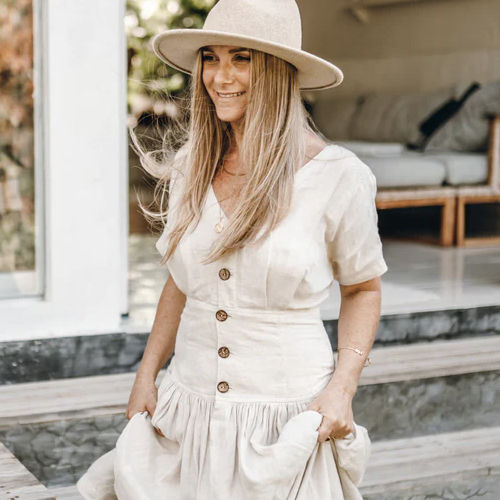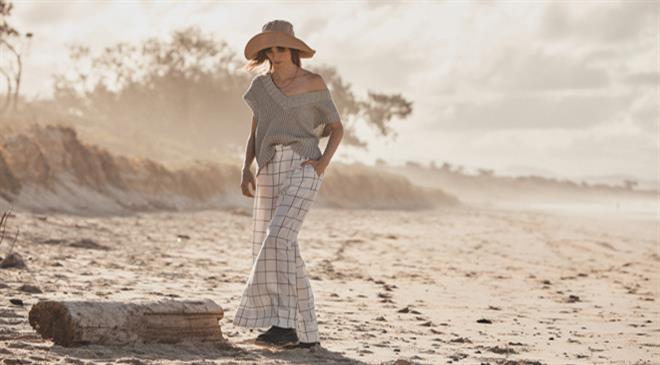
Jodi Gibbs
Designer
Label - Bird & Kite
I see sustainability as a journey, not a destination
Bird & kite is a sustainable and slow fashion brand based in Australia. In an interview with Fibre2Fashion, Bird & Kite’s founder Jodi Gibbs talks about slow fashion and the sustainable approaches practised by her brand.
Fibre2Fashion: What attracted you towards the fashion industry and how would you describe your journey?
Jodi Gibbs:
I was never really attracted to the fashion industry specifically. My journey started with my mother making all of our clothes by hand when we were children, and as soon as I was old enough to hold a needle, she taught me to sew. Apparently, as a young child I was very particular about what I wore and combinations of colours and textures that I wore. So, it's in my DNA. The fashion industry itself was not at all on my radar and I never really subscribed to what the industry dictated, rather, I followed my own instinct. This was the driving force behind my brand. Bird & Kite emerged organically as a spin-off from years of rummaging through Op Shops, cutting things up and redeveloping them into my own styles and designing my own wardrobe for pleasure. I think the fashion industry should be considered a resource for individuals to express their own style. I always feel so inspired when I see our customers wearing Bird & Kite pieces in their own way.
F2F: How would you define the aesthetics of your collection?
JG:
Raw, luxurious, textural, romantic, indulgent yet rooted in nature, inspired by vintage bohemia.
F2F: What does sustainability and slow fashion mean to you and how do you include them in your creations?
JG:
I see sustainability as a journey, not a destination. I believe this because, as an industry, fashion has so far to go and there will always room to improve as we adapt to a changing world and changing opportunities to improve. There is no such thing as a 100 per cent sustainable brand, I believe. If a brand claims this, it would be a red flag for me. The industry makes it hard to be 100 per cent sustainable. You have to keep looking for new ways to be sustainable amongst a sea of unsustainable cheaper manufacturing and operational practices. I do, however, see change occurring and this is so hopeful and inspiring.
- Minimising fabric waste by making useful products out of our fabric waste that we give to our customers. Every customer receives a free scrunchie made with excess fabric. We also make scarves and wraps.
- Donating any excess fabric to Balinese women who weave ‘rage rugs’ with fabric offcuts and sell them, providing them with an income to support their families.
- Providing our customers with the option to purchase online from our pre-purchase model ensures that we do not over produce and only cater to the natural demand.
- No child or underage labour
- Fair payment of a living wage and reasonable hours of work
- Safe and healthy workplaces
- No forced labour
- Women’s rights observed
- Support of working mothers
- Supporting religious and cultural practices.
F2F: With so many sustainable brands coming forward, how do you ensure your label stands out?
JG:
Just stay authentic and true to what we do, continue to be transparent and continue to look for new ways that we can improve and engage with sustainability. Stay vigilant and open. I see more conscious brands on the market as a good thing and not a competition. I see it as an inspiration.
F2F: Sustainable ensembles come with a price. What is your take on it?
JG:
It’s important for consumers to understand that all the small and big choices that conscious brands make to support sustainability come at a cost. If it was cheap to produce sustainably, wouldn’t all brands choose to do so? I think this can be applied to all products that can be purchased in retail. If the product is very cheap, I think consumers should be asking themselves, how is that product produced so cheaply? Who is making the profits on such an inexpensive item? Are the makers being paid a fair and liveable wage and are their working conditions safe and healthy? Are the materials used being created with the planet in mind? Was the product designed to live a long time or was it made to last for only a season and end up in landfill? It’s about educating the consumer and slowly changing attitudes. Having said this, we try to keep our brand accessible to the average consumer and we hope that with time, sustainable production and manufacturing processes will become more accessible to all brands, as, over time, conscious brands become the norm rather than the exception.
F2F: What advice would you like to share with fashion enthusiasts to elevate their wardrobe for Spring /Summer season?
JG:
I encourage people to shop with thoughtfulness and to have fun with it. It feels good to wear clothes that are made with meaning. Fashion should not be just about looking good but more about feeling good. And there are so many beautiful and conscious brands out there these days to choose from, including Bird & Kite!
F2F: What is the vision for your label for forthcoming years? Do you have any expansion plans?
JG:
My vision and greatest hope is that I can keep making beautiful things as consciously as I can for as many people as will enjoy them. I love what I do, and I want that to always be the driving force behind Bird & Kite no matter what the heights the brand may grow to.

Anurag Batra
Rahul Mehta
Fanny Vermandel
Rahul Mehta
Abhay Gupta
Aseem Prakash
Gabi Seligsohn
Pradip Mehta
Bill D’Arienzo
Arun Sirdeshmukh


20230103183907.png)

_8.JPG)








